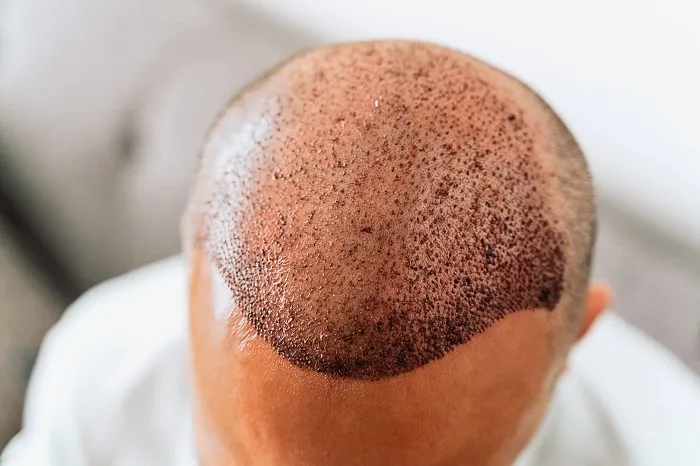After undergoing a hair transplant, one of the most common concerns for patients is the healing process, specifically the scabbing and shedding of the scabs that form around the newly transplanted hair follicles. While scabbing is a normal part of the recovery process, understanding how long it takes for the hair transplant scabs to fall off and the factors that influence this timeline is essential. In this comprehensive guide, we will explore various aspects of hair transplant scabs, including the types of hair transplant procedures, recovery time, associated risks, and much more. This information will help you prepare for a smooth recovery and ensure that you achieve the best results from your hair restoration procedure.
Understanding Hair Transplant Scabs
Scabs form as part of the natural healing process after a hair transplant. When hair follicles are transplanted into the scalp, small incisions or puncture wounds are created, which may bleed and then scab over. These scabs are the body’s way of protecting the healing tissue and preventing infection. The scabs generally fall off on their own within a specific period, but the exact timing can vary from person to person. On average, hair transplant scabs typically begin to shed within 7 to 10 days post-procedure, but the entire process may take a bit longer depending on individual factors such as the type of hair transplant, aftercare, and personal healing rates.
Factors Influencing How Long Scabs Take to Fall Off
The duration of scabbing after a hair transplant can be affected by several factors:
Hair Transplant Types: The method used for the hair transplant can influence the healing time. Different techniques, such as Follicular Unit Extraction (FUE) and Follicular Unit Transplantation (FUT), may have varying recovery timelines and scab shedding processes. Learn more about hair transplant types here.
Scalp Sensitivity: Some individuals have more sensitive skin, which may lead to a longer period of scabbing or a more noticeable scab formation.
Aftercare Practices: Proper aftercare is crucial for a faster recovery. Following your surgeon’s aftercare instructions can reduce the likelihood of scabs becoming infected, which can prolong the shedding process.
Hair Transplant Types and Their Impact on Scab Shedding
The two most common hair transplant techniques are Follicular Unit Extraction (FUE) and Follicular Unit Transplantation (FUT). Both methods involve removing hair follicles from a donor area and transplanting them into the recipient area, but the way the hair follicles are harvested and transplanted differs.
Follicular Unit Extraction (FUE)
FUE is a minimally invasive method where individual hair follicles are extracted from the donor area using a small punch device. Since the incisions made during FUE are small, the healing time is generally quicker, and scabs may fall off sooner compared to FUT. However, it is still important to follow proper aftercare instructions to avoid infection.
Follicular Unit Transplantation (FUT)
FUT, also known as the strip method, involves removing a strip of tissue from the donor area, which is then dissected into individual hair follicles. This method may result in slightly longer scabbing due to the larger incision site, and patients may experience a longer recovery time.
Hair Transplant Recovery Time
The hair transplant recovery time is a key consideration for anyone planning to undergo the procedure. While scabs typically fall off within 7 to 10 days, full recovery can take several months. The newly transplanted hair follicles go through a shedding phase, known as “shock loss,” which is normal and temporary. Over time, new hair growth begins, and the hair continues to mature over the next several months.
The average recovery time for a hair transplant varies depending on the procedure type, but most patients return to their normal activities within 7 to 14 days. To ensure a smooth and successful recovery, it is essential to manage scabs carefully during the initial healing period. Find more details about hair transplant recovery time here.
Hair Transplant Costs and Considerations
When considering a hair transplant, one of the most common questions is about the cost. Hair transplant costs can vary depending on the method used, the clinic’s reputation, and the number of grafts required. On average, hair transplants can cost anywhere from $4,000 to $15,000 or more, depending on the complexity of the procedure and the geographic location of the clinic. Keep in mind that while cost is an important factor, the experience and skill of the surgeon should be prioritized to ensure the best results.
Additional factors that can influence cost include the need for post-procedure medications, follow-up consultations, and any potential revisions or touch-ups. Learn more about hair transplant costs here.
Hair Transplant Risks
Like any surgical procedure, hair transplants come with some risks. Common risks include infection, scarring, and uneven hair growth. However, these risks can be minimized by choosing a qualified and experienced surgeon, following proper aftercare guidelines, and adhering to post-procedure instructions. It is essential to discuss potential risks with your surgeon during the consultation to ensure you have a clear understanding of the procedure.
While scabbing itself is not a significant risk, improper handling or scratching of scabs can lead to infections or scarring, which can negatively affect the outcome of the procedure. Find more information about hair transplant risks here.
Conclusion
The healing process after a hair transplant involves several stages, including the shedding of scabs. While scabs generally fall off within 7 to 10 days, the timeline can vary depending on factors such as the type of procedure, individual healing rates, and proper aftercare. By understanding the typical scab shedding process and taking the necessary precautions, you can ensure a smooth and successful recovery. Always consult with your surgeon for personalized guidance on how to manage scabs and optimize the outcome of your hair transplant.
Related Topics
- How Much Does Fue Hair Transplant Cost
- 9 Side Effects Of Hair Transplantation
- A Hair Transplant In Glasgow: Pros & Cons


